Resin-bound gravel can last between 15 and 25 years in high-traffic areas if installed properly and maintained regularly. Key factors for longevity include using quality materials, ensuring a stable substrate, and installing effective drainage systems. While it provides good slip resistance and durability, it’s not suitable for heavy vehicles due to its load-bearing limits. Regular maintenance, such as sweeping and resealing every few years, is essential to extend its lifespan. For more helpful tips and best practices, continue exploring the topic.
Key Takeaways
- With proper installation using high-quality resin and a well-prepared base, resin-bound gravel can last 15 to 25 years even in high-traffic areas.
- Its durability and slip-resistance make it ideal for busy locations, providing effective load distribution and safety features.
- To ensure longevity and maintain performance under heavy use, regular maintenance is key—cleaning and resealing every 3 to 5 years is recommended.
- The flexible surface can handle minor movements in the base, which helps prevent cracking and displacement, making it a reliable choice for high-traffic applications.
- However, while resin-bound gravel is robust, it may struggle under very heavy vehicle loads, so it’s worth considering alternative surfacing options for such situations.
Understanding Resin-Bound Gravel
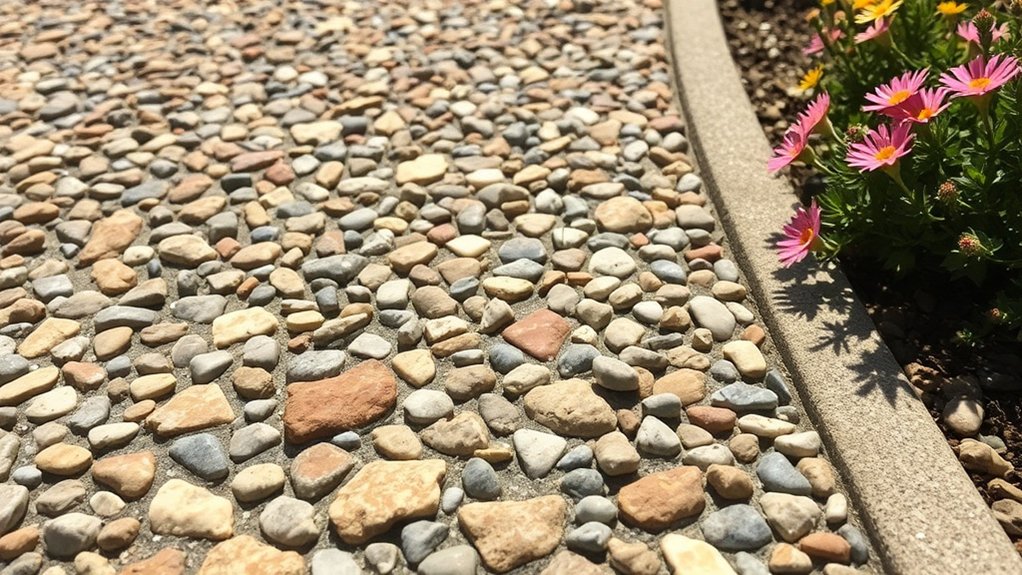
Resin-bound gravel is a contemporary surfacing option that offers both durability and visual appeal.
It’s made from a clear polyurethane resin that binds together graded, washed, and kiln-dried aggregates, typically consisting of 75% coarse aggregate (2-5mm) and 25% finer gravel. This blend ensures a strong bond and a stable surface that resists gravel displacement. The tough resin binding used in resin-bound gravel withstands foot traffic and vehicles with minimal cracking, which is essential for high-traffic areas.
Common aggregates include natural stones like quartz, marble, and granite, which also provide excellent non-slip properties. To achieve the best results, the aggregates must be dry and free from contaminants before being mixed with the resin. The final product is a flexible surface that can handle minor base movements without cracking, making it ideal for a range of uses, especially in high-traffic areas like driveways and walkways. Additionally, the choice of base material, such as macadam for permeability, significantly affects the overall performance and longevity of the resin-bound gravel surface.
Durability and Lifespan Factors
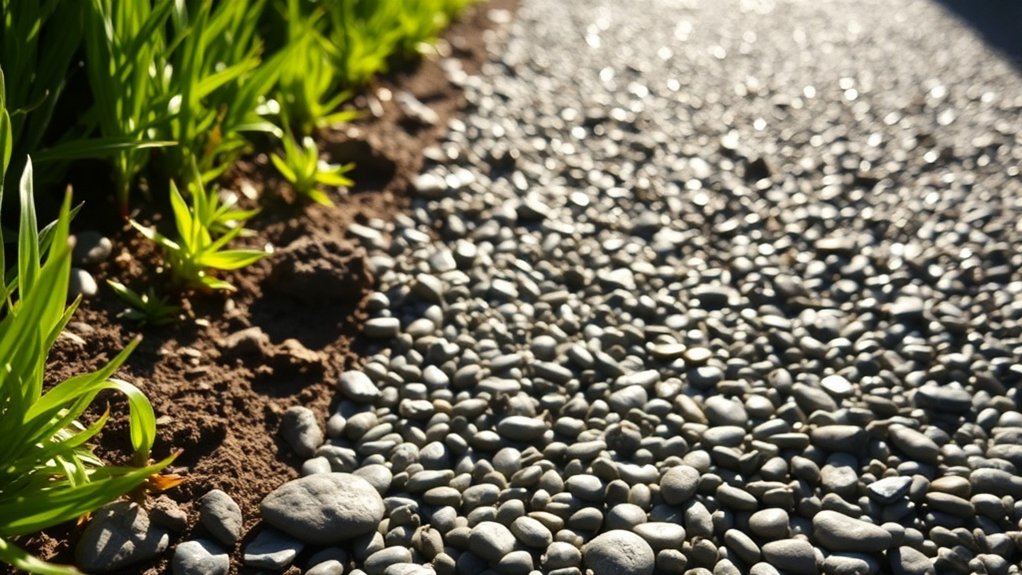
When assessing the durability and lifespan of resin-bound gravel, it’s crucial to focus on installation quality and material choice. If the installation is poorly executed, it can result in structural problems. Likewise, using inferior materials may lead to a surface that can’t endure environmental challenges. Addressing these aspects properly can significantly improve the longevity of your gravel surface. For example, opting for high-quality resin and ensuring that the base is well-prepared can make all the difference in how long your gravel lasts. Additionally, the average lifespan of resin driveways can provide a benchmark for longevity expectations in high-traffic areas, with proper installation conducive to a lifespan of 15 to 25 years.
Installation Quality Importance
Proper installation quality is crucial for ensuring the durability and longevity of resin-bound gravel surfaces, as it significantly impacts the material’s performance in various conditions.
To achieve the best results, focus on key installation techniques. This includes stabilising the substrate, integrating an effective drainage system, and ensuring thorough compaction to create a solid base. Additionally, ensuring compliance with Sustainable Urban Drainage Systems (SUDS) regulations can further enhance the performance of the surface in heavy rainfall areas. A clean and stable foundation is critical for successful installation, as it prevents future cracks or dips in the surface.
The expertise of the installer is vital in executing these techniques correctly. They must manage weather conditions during installation, maintain the right mixing ratios, and follow resin curing times strictly. It is essential to use UV-stable resins to avoid degradation from sunlight, which is crucial for maintaining the integrity of the installation.
For high-traffic areas, consider using increased thickness and specialised resin types. By paying attention to these factors, you can greatly improve the lifespan and performance of your resin-bound gravel surfaces.
Material Selection Impact
The longevity of resin-bound gravel surfaces depends greatly on the materials chosen for both the resin and the aggregates. High-quality resin formulations can enhance bonding and UV stability, potentially extending the lifespan to as much as 30 years.
Using durable natural stone aggregates, such as granite or quartzite, improves performance and ensures high wear resistance in busy areas.
Uniform aggregate size is also important, as it helps with resin distribution and reduces the risk of weak points and cracking. The resin-to-aggregate ratio plays a crucial role; finding the right balance prevents brittleness while allowing for flexibility under heavy loads.
Local climate conditions should be considered as well. Using frost-resistant materials and UV-stable resins can help prevent weather-related damage.
Performance Under High Traffic Conditions
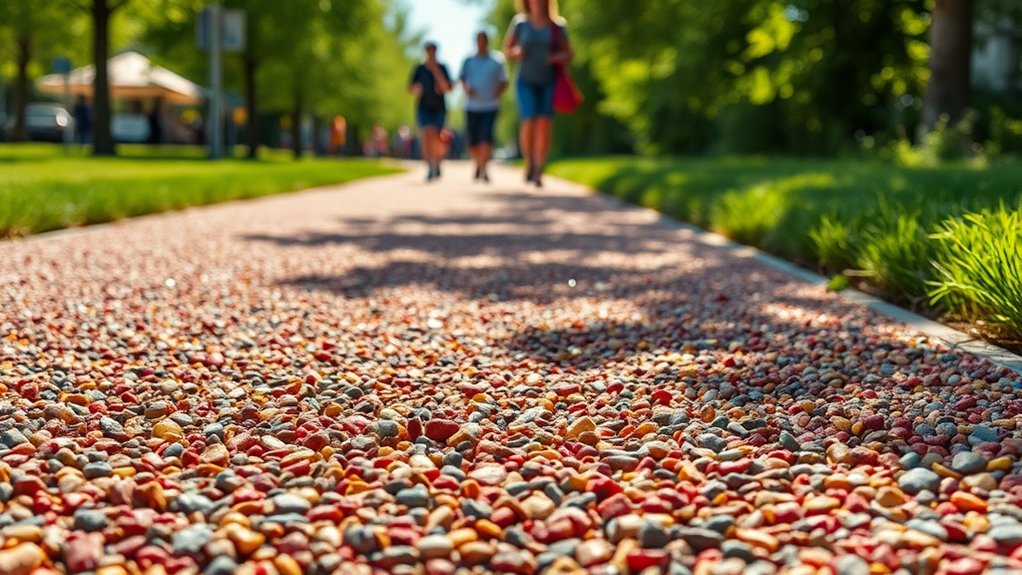
When assessing the performance of resin-bound gravel in high traffic areas, you’ll find it remarkably durable under both foot and vehicle movement.
The strong bond between the resin and aggregates ensures minimal shifting and wear, even in busy locations like shopping centres or parks.
Its slip-resistant properties also enhance safety, making it a dependable option for areas with heavy use.
Durability Against Heavy Traffic
Resin bound gravel is known for its durability, but its performance under heavy traffic depends on key factors.
Proper substrate preparation and accurate resin-aggregate mixing are crucial to prevent cracking and displacement. Heavy vehicles, like delivery lorries, can put a lot of stress on the surface, particularly when turning or stopping.
It’s important to ensure proper load distribution; a solid base beneath the gravel helps manage these stresses effectively.
While resin bound gravel can handle substantial foot traffic, areas subjected to very heavy loads may need alternative surfacing for better longevity.
Regular maintenance is also vital to keep it performing well.
Slip Resistance Features
Slip resistance is crucial in high-traffic areas where safety is paramount. Resin-bound gravel surfaces adhere to strict safety standards, often exceeding minimum requirements. For instance, the ResinBound UVR Pro has Pendulum Test Values (PTV) of 51 (wet) and 62 (dry) without any additives. When crushed glass is added, these scores improve significantly, reaching 74 (wet) and 80 (dry).
| Material | Wet PTV | Dry PTV |
|---|---|---|
| ResinBound UVR Pro | 51 | 62 |
| Crushed Glass | 74 | 80 |
| RonaDeck Blends | Low | Low |
Using anti-slip aggregates and ensuring proper installation can further enhance slip resistance, ensuring safety even in wet or icy conditions.
Safety Features and Slip Resistance
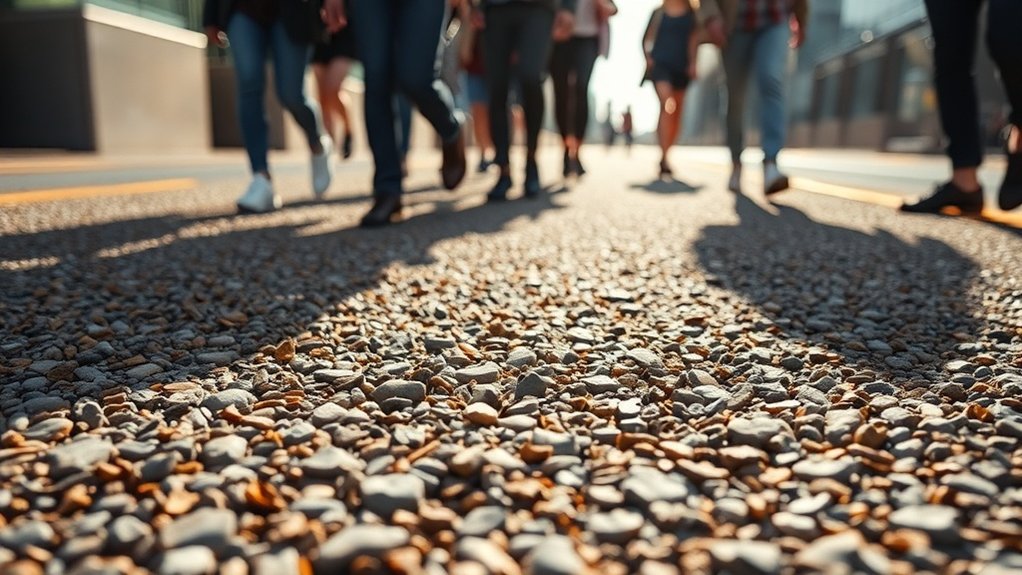
How does resin-bound gravel improve safety with its innovative design? This surface boasts excellent slip resistance, reducing the risk of slipping in both dry and wet conditions, and meets BS 8204-6:2008+A1:2010 standards.
By incorporating anti-slip aggregates during installation, it enhances traction, especially in areas prone to accidents, like slopes. Its permeable nature allows for effective drainage, significantly lowering the chances of slip hazards due to standing water.
The unique texture of the aggregates also offers better grip compared to smoother surfaces like tarmac. These safety features, along with adherence to Sustainable Drainage Systems guidelines, make resin-bound gravel a dependable choice for busy areas, ensuring the safety of pedestrians and vehicles in various weather conditions.
Maintenance Requirements for Longevity
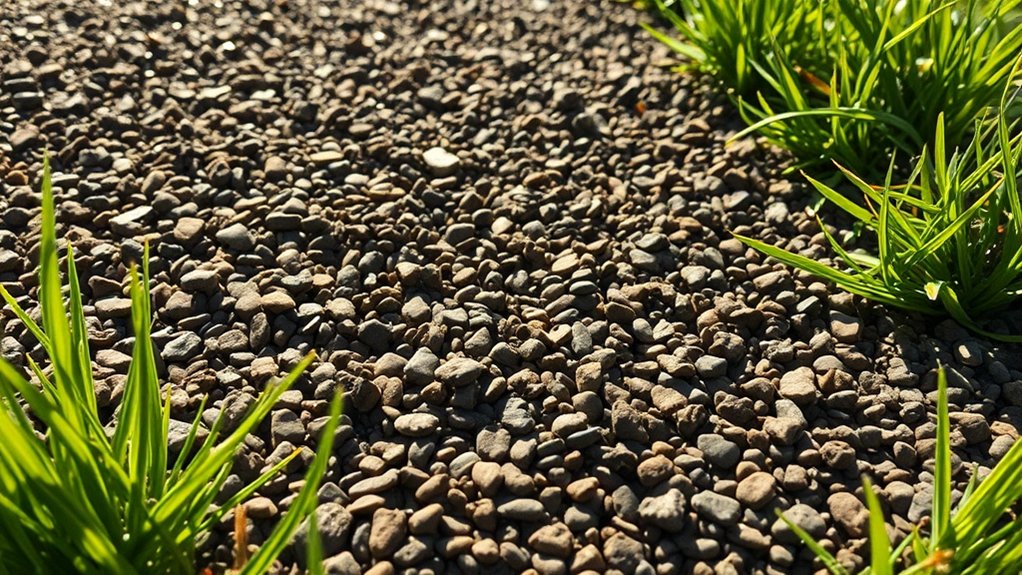
Maintaining resin-bound gravel is essential for ensuring its longevity and performance in various conditions. Regular cleaning, such as sweeping weekly and occasional low-pressure washing, helps prevent debris accumulation and surface wear. Regular inspections for damage, along with prompt repairs, can tackle minor issues before they become significant problems.
| Maintenance Task | Frequency |
|---|---|
| Sweep debris | Weekly |
| Low-pressure wash | Occasionally |
| Visual inspections | Monthly |
| Reseal surface | Every 3-5 years |
| Remove weeds and algae | As needed |
Environmental Benefits of Resin-Bound Gravel
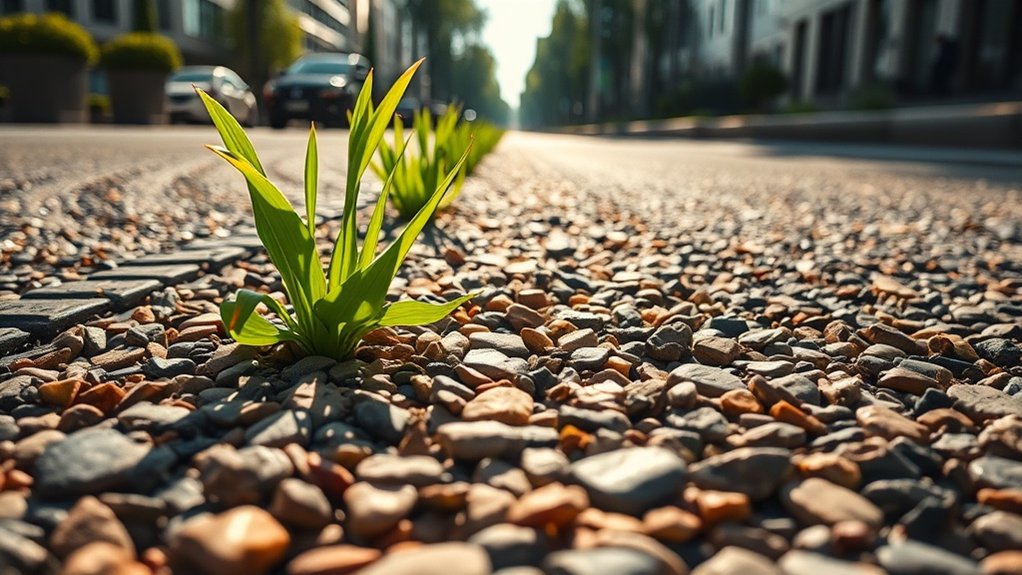
Urban development can often harm the environment, but resin-bound gravel presents a sustainable alternative that improves water management and reduces ecological impact.
Its permeable surface allows rainwater to soak in, which helps to minimise surface runoff and reduces the risk of flooding. This feature supports natural groundwater replenishment and meets the requirements of Sustainable Urban Drainage Systems (SUDS), which are crucial in cities.
Moreover, resin-bound gravel has a low carbon footprint during installation and lasts for 20 to 30 years, significantly cutting energy usage and emissions.
By using aggregates sourced from recycled materials, this paving option helps reduce waste and conserve natural resources. Additionally, it helps combat the urban heat island effect, leading to a cooler environment while also supporting local wildlife.
Importance of Quality Installation
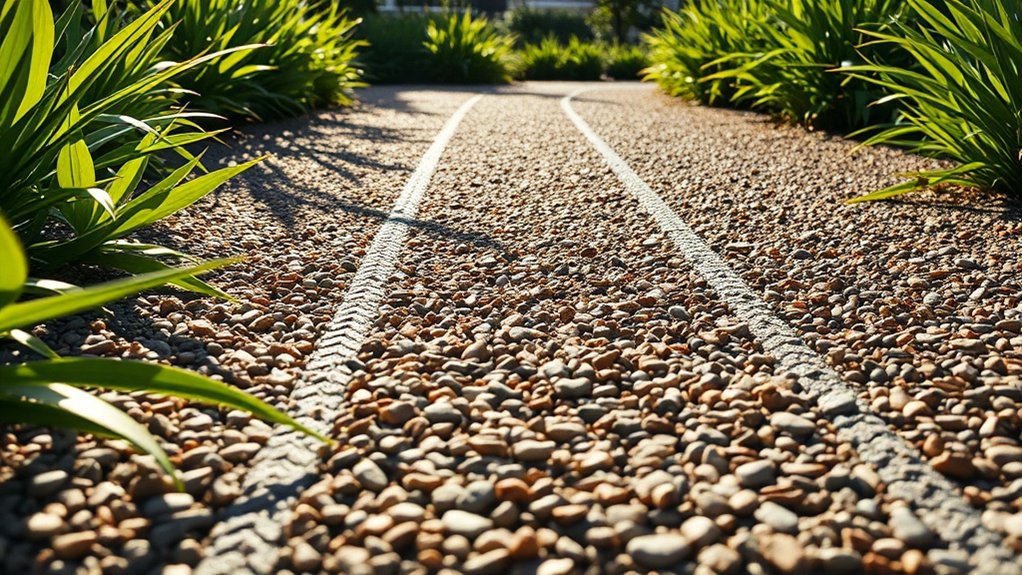
When installing resin-bound gravel, ensuring high-quality substrate preparation and selecting the right resin is crucial.
Properly compacting the base and using UV-stable, compatible resin ensures strong adhesion and long-lasting results. Cutting corners here can result in early failures and higher maintenance costs in the long run.
For example, if the base isn’t compacted well, you might find your surface cracking or sinking in places.
It’s best to invest time and resources upfront to avoid these issues later.
Proper Substrate Preparation
Proper substrate preparation is crucial for ensuring the longevity and durability of resin-bound gravel installations.
Begin by thoroughly cleaning the surface with a power washer to eliminate dirt, moss, and organic matter that could hinder adhesion. Next, address any potholes or cracks and ensure the substrate is level; uneven surfaces can cause premature wear, especially in busy areas.
For new installations, excavate to a depth of 150mm and lay a well-compacted sub-base, such as MOT Type 1 stone, to provide the necessary support.
It’s also important to incorporate proper drainage solutions and ensure the surface is dry before application.
Quality Resin Selection
Choosing high-quality resin is crucial for a durable and long-lasting resin-bound gravel surface. The right type of resin ensures excellent UV resistance, preventing yellowing and fading, while also providing anti-slip properties for safety.
Furthermore, good chemical resistance protects against damage from oils and other contaminants.
- Use proper mixing techniques to maintain a strong resin-to-aggregate ratio, typically around 7%, which is vital for surface cohesion.
- Ensure that your aggregate is compatible with the resin to prevent binding issues that can lead to surface wear.
- Conduct permeability tests to ensure effective water drainage, which is essential for the longevity of the surface.
Don’t overlook curing times, as they significantly affect the final strength and durability of your installation.
Limitations in Heavy Traffic Scenarios
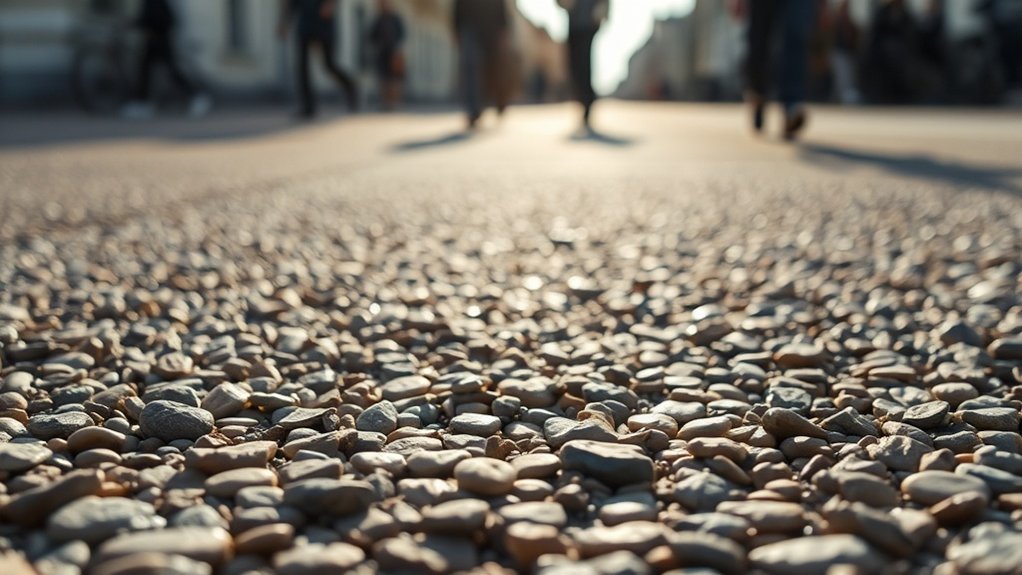
Resin-bound gravel looks great for pathways and light traffic areas, but it doesn’t hold up well under heavy traffic. The resin binder can weaken with constant use, leading to cracks. It’s crucial to manage traffic effectively, as heavy vehicles can quickly damage the surface.
| Limitation | Impact |
|---|---|
| Load-bearing capacity | Not ideal for heavy vehicles |
| Surface abrasion | Lowers slip resistance |
| Repair frequency | Raises lifecycle costs |
When it gets damaged, patching is necessary, but this can affect the overall surface integrity. Environmental factors, like UV exposure and freeze-thaw cycles, also increase the need for regular upkeep in busy areas.
Alternative Surfacing Options
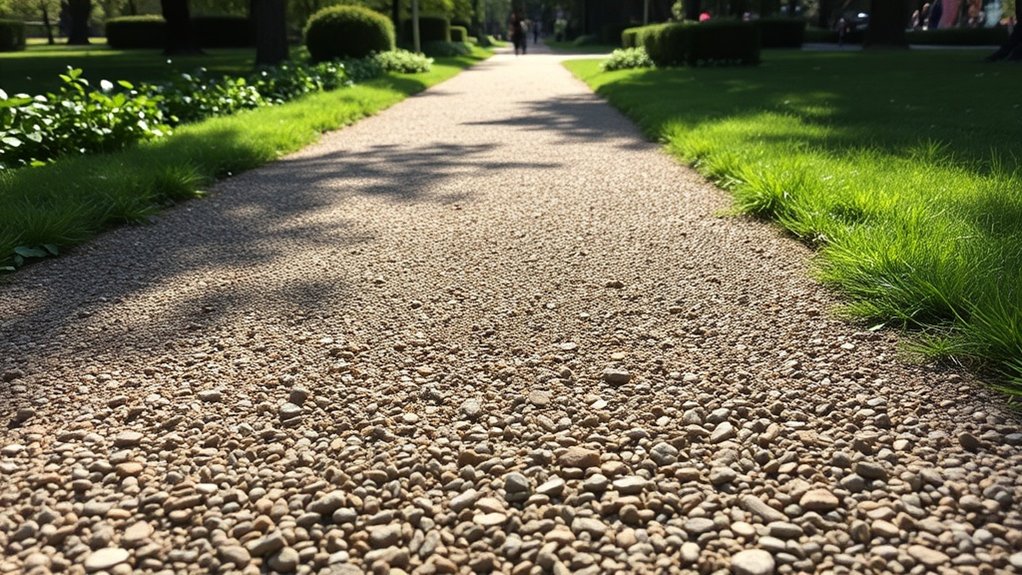
High-traffic areas often highlight the shortcomings of resin-bound gravel, making it essential to consider alternative surfacing options that can better handle the demands.
Here are some effective alternatives:
- Permeable pavers: These allow water to drain through, reducing runoff and aiding groundwater recharge, making them suitable for heavy loads like commercial vehicles.
- Synthetic surfaces: Products such as NatraTex combine vibrant aesthetics with durability, ensuring low maintenance and preventing weed growth.
- Gravel options: Permeable gravel creates natural surfaces that minimise flooding and promote vegetation, offering a cost-effective solution for temporary use.
While traditional surfaces like tarmac and concrete might seem attractive at first, their higher maintenance and repair costs can be a burden over time.
Considering these alternatives can significantly improve performance in high-traffic areas.
Best Practices for Maximizing Lifespan
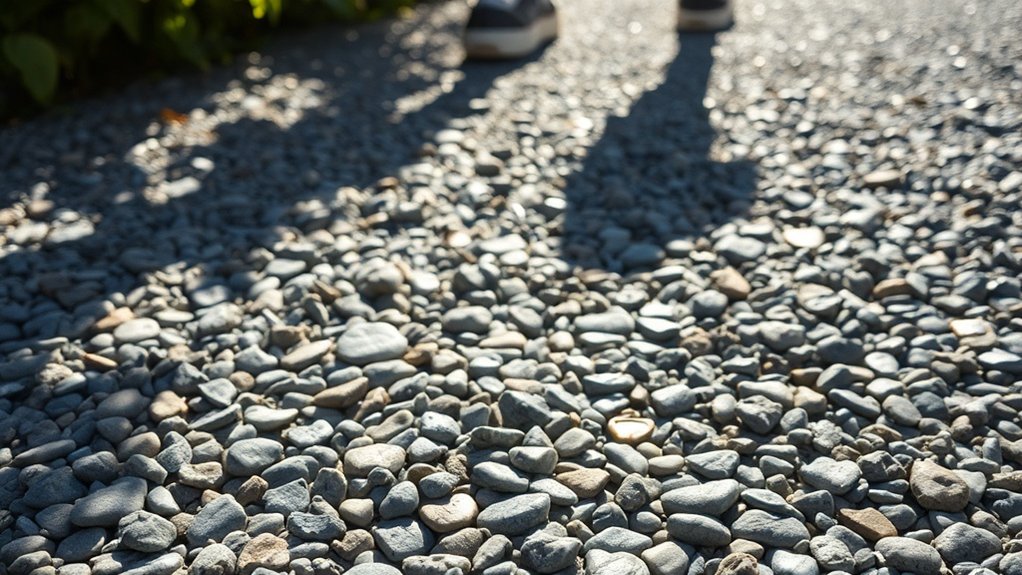
To extend the lifespan of resin-bound gravel surfaces, adhere to best practices centred around quality materials, professional installation, and regular maintenance.
Use high-quality, UV-stable polyurethane resin along with evenly graded aggregates for improved durability and resistance to weather conditions. Hire experienced contractors to ensure proper mixing and installation, which includes a stable sub-base and the correct resin-to-aggregate ratios.
Regular cleaning and inspections are vital; address any minor damage quickly to keep the surface looking good.
Manage foot and vehicle traffic by designating specific paths and informing users about weight limits.
Finally, tailor your maintenance schedule to local weather patterns to prevent excessive wear.
Frequently Asked Questions
How Does Resin-Bound Gravel Compare to Traditional Asphalt?
Resin-bound gravel is more durable than traditional asphalt, lasting longer and resisting cracks effectively. It requires minimal maintenance, unlike asphalt, which needs regular sealing and patching. This can lead to higher long-term costs and effort for homeowners. For example, with resin-bound gravel, you can enjoy a beautiful driveway without the constant upkeep that asphalt demands.
Can Resin-Bound Gravel Be Installed Over Existing Surfaces?
Yes, you can install resin-bound gravel over existing surfaces in the UK. However, it’s crucial to prepare the surface properly. Ensure the base is stable, clean it thoroughly, and adhere to installation guidelines. This will help achieve good adhesion and durability, preventing problems like cracking or peeling.
What Colors and Textures Are Available for Resin-Bound Gravel?
Resin-bound gravel offers a wide range of colours, from earthy tones to vibrant hues. You can choose from smooth, natural stones or graded aggregates, providing both visual appeal and practical benefits for your outdoor surfaces.
How Does Temperature Affect the Installation of Resin-Bound Gravel?
Temperature fluctuations significantly impact how you install resin-bound gravel. In colder weather, the curing process slows down, while high temperatures can speed it up, which may cause surface problems. For example, if it’s too hot, the resin might set too quickly, leading to a less durable surface. Keeping an eye on the temperature during installation ensures proper curing and improves the longevity of your gravel.
Is Resin-Bound Gravel Suitable for Residential or Commercial Use?
Yes, resin-bound gravel is durable enough for both residential and commercial use. For homes, it enhances the look of driveways and paths while providing a safe surface. In commercial settings, it can handle heavy foot traffic and offers sustainable drainage with minimal upkeep. It effectively meets a variety of needs.
Conclusion
In summary, resin-bound gravel can be a robust option for high-traffic areas, but its durability depends on several factors, such as the quality of installation and ongoing maintenance. Think of it like a well-loved bicycle; if you neglect it, it won’t last. By adhering to best practices and recognising its limitations, you can extend its lifespan and effectiveness. Ultimately, investing in proper upkeep will ensure your surface remains both functional and visually appealing for years to come.
